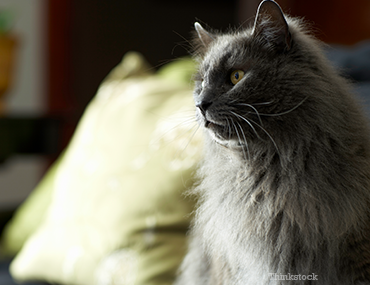
What is a feline aortic thromboembolism?
Feline cardiogenic arterial thromboembolus (ATE), also known as “saddle thrombus,” is a devastating complication of heart disease in cats. Heart disease can cause disturbances in blood flow through the heart that can lead to the formation of blood clots. In cats, these blood clots can travel downstream and become lodged in the femoral arteries -- the main arteries that provide blood flow to the hind limbs. When a saddle thrombus occurs, there is a loss of blood flow to the hind legs causing pain, decreased pulses, cold limbs and paralysis.
Who is at risk of aortic thromboembolism?
Cardiogenic arterial thromboembolus occurs most commonly in cats with advanced heart disease and is rarely seen in dogs. While certain breeds are more prone to heart disease, like the Maine Coon, Ragdoll, Sphynx, Persian, and Abyssinian; saddle thrombus can occur in cats of any breed or age, although it is usually seen in cats 8 years and older.
Symptoms of aortic thromboembolism
- Sudden inability to use back legs
- Dragging rear limbs
- Vocalizing
- Cold rear limbs
- Pain
Diagnosis of aortic thromboembolism
Aortic thromboembolism may be diagnosed by physical examination. Your veterinarian may also suggest blood work and a cardiac work-up, which may include chest radiographs (x-rays) and/or an ultrasound of the heart (echocardiogram).

Treatment of aortic thromboembolism
Available treatments have included anti-thrombotic drugs or surgery to remove the clots but they have not been very successful. Many anti-thrombotic drugs have been used to prevent recurrences in cats with heart disease. Recent studies indicate that clopidogrel (Plavix) appears to be superior to aspirin for the prevention of recurrent ATE in cats. Cats may recover function in their rear limbs but unfortunately remain at high risk for developing additional aortic thromboembolisms.
Prognosis for aortic thromboembolism
Despite treatment, the prognosis is poor and many cats are euthanized due to recurrences and poor quality of life. However, newer anti-thrombotics that will hopefully help cats with aortic thromboembolisms live longer, are currently being evaluated and may be available in the next five years.
Clinical trials
There are several current studies looking into different treatment options for saddle thrombi and also for ways to prevent new clots from forming. Hopefully, the work of these researchers will determine the most effective medications available to prevent cats from developing blood clots and also discover a better treatment option for cats that already have a “saddle thrombus.” To find out about current clinical trials speak with your veterinarian.
Prevention
Aortic thromboembolism is an unfortunate complication of heart disease. Since early heart disease is asymptomatic, it is best to take your cat to the veterinarian at least once a year to screen for heart disease. Your veterinarian will listen to your pet’s heart for abnormal sounds like murmurs or irregular rhythms and will look for other subtle signs of heart disease. If your veterinarian suspects heart disease, they may measure NT-proBNP blood pressure or suggest additional tests like x-rays, cardiac ultrasounds, or ECGs to confirm the diagnosis and determine the cause so that treatment can be started. Starting treatment for heart disease earlier can improve quality of life and extend life expectancy.
If you think your cat may have or had a saddle thrombus see your veterinarian as soon as possible.
If you have any questions or concerns, you should always visit or call your veterinarian -- they are your best resource to ensure the health and well-being of your pets.
